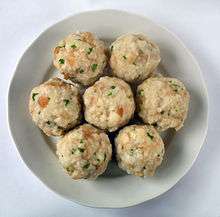Knödel
|
Semmelknödel | |
| Type | Dumpling |
|---|---|
| Place of origin |
Austria Germany Italy |
| Region or state | Central Europe |
| Main ingredients | Potatoes or bread or flour |
| Variations | See list |
|
| |
Knödel ("dumpling", sing. der Knödel), or Klöße (sing. der Kloß) are boiled dumplings[1] commonly found in Central European and East European cuisine. Central European countries in which their variant of knödel is popular include Austria, Germany, Hungary, Serbia, Croatia, Slovenia, Slovakia, and the Czech Republic. They are also found in Scandinavian, Romanian, Northern eastern Italian cuisine, Ukrainian and Belarusian cuisines. Usually made from flour, bread[1] or potatoes,[1] they are often served as a side dish, but can also be a dessert such as plum dumplings, or even meat balls in soup. Many varieties and variations exist.
Etymology
The word Knödel is German and derives from the Latin word nodus (knot). From the Old High German chnodo and the Middle High German knode it finally changed to the modern expression.[2] Knödel in Hungary are called gombóc or knédli; in Slovenia, "knedl(j)i" or (less specifically) "cmoki"; in the Czech Republic, knedlík (plural: knedlíky); in Slovakia, "knedľa" (plural: knedlíky); in Luxembourg, Kniddel(en); in Bosnia, Croatia, Poland and Serbia, knedle; and, in Italy, canederli [kaˈneːderli]. In some regions of the United States, klub is used to refer specifically to potato dumplings. A similar dish is known in Sweden (kroppkakor or pitepalt) and in Norway, raspeball or komle filled with salty meat; and in Canada, poutines râpées. In Bukovina they are known as cnigle.
Varieties
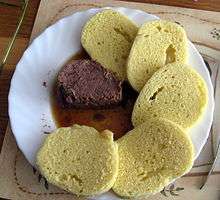
Knödel are used in various dishes in Austrian, German, and Czech cuisine. From these regions, knödel spread throughout Europe. At the turn of the 20th century, it was commonly said that a Czech girl is not prepared to marry until she can cook this dish.[3]
- Leberknödel are large dumplings made of ground liver and a batter made of bread soaked in milk and seasoned with nutmeg or other spices, boiled in beef stock and served as a soup. Klöße are also large dumplings, steamed or boiled in hot water, made of dough from grated raw or mashed potatoes, eggs and flour. Similar semolina crack dumplings are made with semolina, egg and butter called Grießklößchen (Austrian Grießnockerl, Hungarian grízgaluska)[4] Bread dumplings (Semmelknödel) are made with dried white bread, milk and egg yolks (are sometimes shaped like a loaf of bread, and boiled in a napkin, in which case they are known as napkin dumplings or Serviettenknödel). If bacon is added they are called Speckknödel.[1] Thüringer Klöße are made from raw or boiled potatoes, or a mixture of both, and are often filled with croutons or ham.
- In Austria and Hungary, large sweet dumplings or plum dumplings called Zwetschgenknödel or Gombotzen are made with flour and potato batter, by wrapping the potato dough around whole plums or apricots, boiled and rolled in hot buttered caramelized bread crumbs.[4][5] Topfenknödel are made with quark cheese (Topfen), (Hungarian túrógombóc), traditionally topped with cinnamon sugar and served with apple sauce or with streusel.
- In Brazil, German immigrants traditionally make Klöße with white rice, wheat flour and eggs, mixing them into a sturdy dough, shaping them in dumplings and boiling them.
- Königsberger Klopse are not dumplings; they are made from ground meat and are related to Frikadeller.
- Matzah balls could be considered Knödels made from matzah meal. The Yiddish word for Matzah balls, "קניידל" (kneydl), is cognate to Knödel. Matzah balls originated among Ashkenazi Jewish groups in Eastern or Central Europe.
Gallery
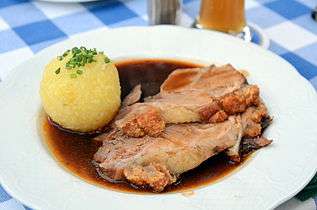 Kartoffelknödel with Schweinsbraten
Kartoffelknödel with Schweinsbraten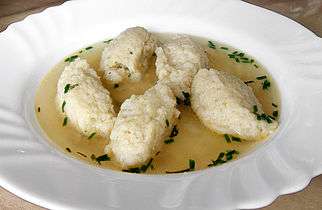 Grießklößchen
Grießklößchen
 Hungarian túrógombóc, made with semolina flour and túró (curd cheese), rolled in breadcrumbs, and served with sour cream and sugar
Hungarian túrógombóc, made with semolina flour and túró (curd cheese), rolled in breadcrumbs, and served with sour cream and sugar- Topfenknödel
- Kartoffelklöße
 Aprikosenknödel, knödel with apricot filling
Aprikosenknödel, knödel with apricot filling Speckknödel in soup
Speckknödel in soup- Spare ribs with Klöße
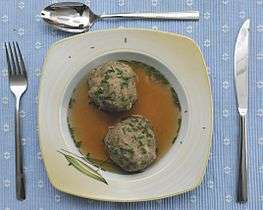 Leberknödelsuppe (liver dumplings in beef stock)
Leberknödelsuppe (liver dumplings in beef stock) Germknödel, dumpling with a mix of poppy seeds and sugar, filled with spicy plum jam
Germknödel, dumpling with a mix of poppy seeds and sugar, filled with spicy plum jam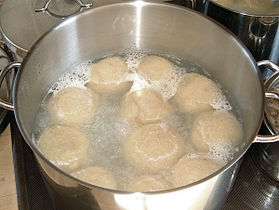 Knödel boiling
Knödel boiling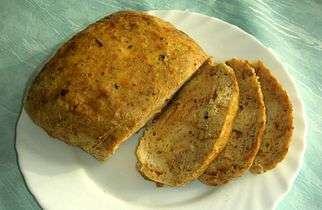 Serviettenkloß
Serviettenkloß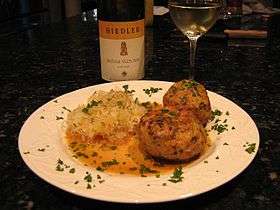 Speckknödel
Speckknödel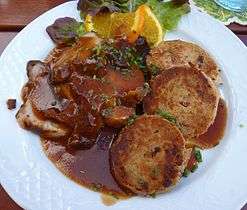 Braised pork served with Serviettenknödeln
Braised pork served with Serviettenknödeln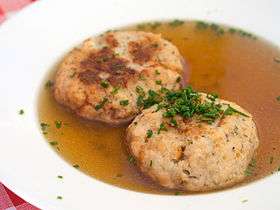 Tiroler Käseknödelsuppe, clear broth served with bread-and-cheese dumplings
Tiroler Käseknödelsuppe, clear broth served with bread-and-cheese dumplings
See also
- Dampfnudel, sweet bread
- Germknödel, steamed or boiled yeast dough
- Kluski, Polish name for concept
- Plum dumplings, commonly known as knedle
- Kroppkaka, Swedish dish
- List of dumplings
- Matzah ball (kneydl)
- Pitepalt
- Poutine râpée
References
- 1 2 3 4 McMeel, Andrews (2007). 1001 Foods To Die For. Andrews McMeel Publishing. p. 218. ISBN 978-0-7407-7043-2.
- ↑ in: Epikur. Journal für Gastrosophie, 01/2013, on 22 November 2015
- ↑ "Pork, sauerkraut and dumplings". Czech Specials. 2 January 2014. Archived from the original on 8 March 2014.
- 1 2 Gundel, Karoly (1992). Gundel's Hungarian cookbook. Budapest: Corvina Könyvkiadó. pp. 71, 116. ISBN 963-13-3600-X. OCLC 32227400.
- ↑ Meyer, June V.; Aaron D. Meyer (1997). June Meyers Authentic Hungarian Heirloon Recipes Cookbook. OCLC 556959201. Retrieved 25 October 2012.
Further reading
- Fercher, D.; Karrer, A. (2013). Austrian Desserts and Pastries: 108 Classic Recipes. Skyhorse Publishing Company, Incorporated. p. 379. ISBN 978-1-62873-134-7.
External links
| Wikimedia Commons has media related to Knödel. |
- Klöße/Dumplings
- Acadian Heritage Portal, in French – Video and historical facts on the Acadian Poutine râpée
